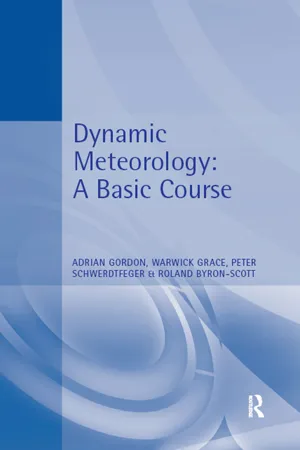![]()
1
INTRODUCTION: UNITS AND DIMENSIONS
1.1 HISTORICAL PERSPECTIVE OF METEOROLOGY
During the first part of the present century the term meteorology really meant the study of all aspects of the atmosphere. But it tended to emphasize the weather in all its variety of manifestations: the simple and the extreme, the sunny days we all enjoy, the more extreme conditions we bear and suffer and swear at. The study was particularly concerned with weather maps, or synoptic charts as they are referred to by those who prepare and analyse them, and to forecasting the weather using the weather map as a practical tool. The classic text in the early days of the century was Sir Napier Shaw’s four-volume masterpiece Manual of Meteorology, followed in the 1930s by Sir David Brunt’s Physical and Dynamic Meteorology. Even in those comparatively early days the role of mathematics was indispensable. Yet, it often seemed most difficult to follow the equations. Meteorology was only taught at a few universities – Imperial College in London, MIT (Massachusetts Institute of Technology) in the USA in the English-speaking world, but it was also advancing rapidly in Scandinavia and other European countries. It was mainly taught as a postgraduate specialist course leading to Master and PhD degrees.
In the middle 1930s, in a time of recession and depression, meteorology received a big boost. This was due to the demands of the rapidly expanding airline industry, particularly in the USA. Jobs were offered to qualified meteorologists to prepare flight weather forecasts for airline operations. A few years later the outbreak of World War II intensified the demand for weather forecasters. Training courses were established and filled by those who only had a rudimentary background of mathematics and physical science. During the latter half of this century the term meteorology tended to be displaced by the more erudite term ‘atmospheric physics’ or ‘atmospheric science’. This transformation was in part due to a certain elitism that meteorology was too much concerned with weather maps and weather forecasting which, before the days of numerical prediction models, were thought by mathematicians and physicists to be a kind of technical trade beneath their professional abilities. But in this work we will not show disrespect to the original term, which is still useful when we wish to subdivide the subject into more specialized fields of interest.
Thus a main field of interest here is called dynamic meteorology. The word dynamic is used a great deal when it is desired to convey that something has energy and movement. It is defined in the dictionary as motive force. Thus, dynamic meteorology applies our knowledge of mathematics and of physical processes to explain and describe the motions and energy transformations which occur in the atmosphere to produce our weather, and eventually, our climate. In turn it is convenient to subdivide dynamic meteorology into headings which concern the thermodynamics and the dynamics of the atmosphere. The former concerns the effect of the influence of heat in its various forms on the vertical and horizontal structure of the atmosphere while the latter concerns and describes the resulting motions.
But we will also touch on synoptic meteorology. This heading covers the scientific techniques used in forecasting the weather by means of the analysis of synoptic charts of the surface and upper level patterns of barometric pressure, temperature and humidity. A further subdivision is that of physical meteorology which deals among other things with the heat budget, balancing the short-wave radiation directly received from the sun with the long-wave radiation emitted and received by the earth’s surface, by clouds and by the atmosphere itself. This balance determines the mean temperature of our planet.
Further branches of meteorology include mesometeorology, which covers the study of meteorological processes and motions on a scale of the size of local topographical or surface features or of thunderstorm or squall line size, and micrometeorology, which covers processes and motions on the scale of a few metres or even centimetres above the land or sea surface.
Finally, the heading which has a long classical history, but which has recently undergone a rebirth to become the most important of all subheadings, because it includes all, is climate. From its origins of presenting maps of mean temperature and other observations for different parts of the world it now embodies all of the physics and mathematics of the other branches in the large numerical climate models which not only reproduce the actual climate of the planet, but attempt to predict future climates within the broad concept of ‘climate change’.
Once again, meteorology has a p...
